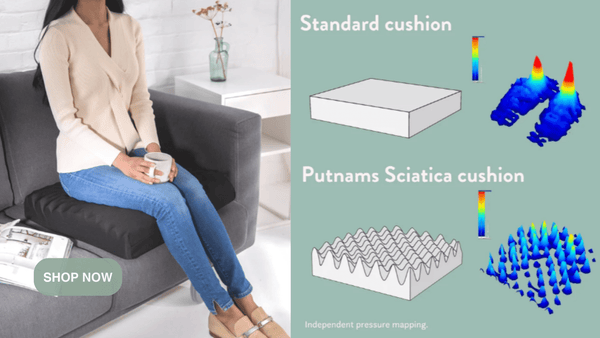
Living with Sciatica: Strategies for Dealing with Chronic Pain
Sciatica, a condition characterized by pain radiating down the path of the sciatic nerve, can significantly affect your life. The discomfort can range from mild annoyance to an excruciating, life-altering issue.
The pain and discomfort caused by chronic sciatica can be relentless with bouts lasting between 4 and 6 weeks!
Living with sciatica can feel like navigating a constant storm of discomfort. However, it's important to remember that you're not alone, and there are strategies available to help you manage this chronic pain.
It is paramount to address signs of sciatica immediately before the pain becomes unmanageable.
You are not alone. Sciatica effects approx 40% of people in the UK at some point in their lives. The main demographics effected is 45-65 years olds and the experience can be fleeting or more long term.
As with most conditions it is crucial to get an accurate and quick diagnosis as sciatica won't simply go away on it's own. Sciatica might be diagnosed as any of the following;
- Radicular pain
- Lumbar radiculopathy
- Lumbosacral radicular syndrome
Understanding Sciatica
Sciatica, characterized by pain radiating along the path of the sciatic nerve, is often caused by underlying conditions such as herniated disks or spinal stenosis. It can manifest in various ways, including lower back pain, hip pain, and numbness in one leg.
These symptoms can significantly impact your daily activities and overall well-being. Seeking professional medical advise sooner rather than later can reduce the impact sciatica has on your everyday life.
According to the NHS definition. Sciatica will impact your bottom, back of your leg, feet and/or toes. This may present itself as a painful stabbing, burning or shooting sensation. In addition sufferers have described it also as a numbness or weakness alongside pins and needles.
Medical Treatments for Sciatica
While sciatica can be debilitating, there are conventional medical treatments available. Over-the-counter pain medications, comfort management and physical therapy are commonly used to manage symptoms.
In more severe cases, epidural steroid injections or surgery may be recommended by healthcare professionals.
Alternative Therapies for Sciatica
In addition to traditional medical treatments, alternative therapies such as chiropractic care, acupuncture, and massage therapy can also provide relief from sciatica symptoms. These therapies aim to reduce pain and improve mobility, enhancing your quality of life.
However, it's crucial to discuss these options with a healthcare provider before starting any new treatment regimen.
Lifestyle Changes for Sciatica Relief
Maintaining a healthy weight and engaging in regular exercise can significantly influence your experience with sciatica. Specific exercises and stretches can strengthen your back muscles, potentially reducing sciatica pain.
Additionally, improving your posture and making ergonomic adjustments can lessen the pressure on your sciatic nerve.
Coping Strategies for Emotional Well-being
Chronic pain can take a toll on your mental health.
Techniques such as mindfulness meditation, deep breathing, and stress management can help you cope with the psychological impact of living with sciatica. Building a support network and reaching out to resources can also provide emotional relief.
Strategies for Dealing with Sciatica Pain
Physical Therapy
Physical therapy is one of the most effective ways to treat sciatica. A physical therapist can provide exercises to correct your posture, strengthen the muscles supporting your back, and improve your flexibility.
Regular Exercise
Regular low-impact exercises such as walking, swimming, or yoga can help reduce sciatica pain. They promote flexibility and strength in the back muscles, preventing further injury.
Use of Sciatica Support Cushions
Putnam's designs a range of sciatica support cushions that can provide relief during a sciatica flare-up. These cushions are specially designed to offer posture support and are ideal for use in your office chair, car seat, or even your sofa at home.
Hot and Cold Therapy
Applying ice packs or heat pads to the affected area can provide immediate relief from sciatica pain. Cold therapy reduces inflammation, while heat therapy relaxes tense muscles that may be compressing the sciatic nerve.
Over-the-counter Medications
Non-prescription anti-inflammatory drugs can be used to alleviate sciatica pain. However, these should only be used under the advice of your GP or other healthcare professional, as long-term use can have side effects.
Mind-Body Techniques
Practices like mindfulness meditation, deep breathing, and progressive muscle relaxation can help manage chronic pain. These techniques help you focus on your body, identify where you're feeling pain, and develop coping strategies.
Healthy Lifestyle
Maintaining a healthy weight, practicing good posture, and quitting smoking are all lifestyle changes that can help you manage sciatica. Extra weight can put pressure on your spine, contributing to the spinal changes that trigger sciatica. Simple efforts in office seating can aid good posture and negate future sciatica flare ups.
Most Asked Sciatica Questions;
What is the best way to relieve sciatica pain?
Physical therapy, regular exercise, and proper use of supportive cushions are key ways to manage sciatica pain.
Is walking good for Sciatica?
Movement as Medicine. Walking can indeed be beneficial for sciatica, promoting circulation and the release of endorphins, which naturally reduce pain. Regular, low-impact exercises such as gentle walks, swimming, or yoga can prevent stiffness while keeping the back muscles strong.
Avoid the temptation to rest in one position for long periods of time.
What NOT to do with sciatica?
Often the pain guide will direct your activities with sciatica. However, it is known that lifting heavy weights, stretching hamstrings and twisting your torso are not conducive with a swift recovery. It's imperative that you maintain low level movement, do not sit in one positions for longer than 20-30 minutes.
Avoid prolonged bed rest.
Ensure wherever possible that correct posture is maintained particularly when using an office chair for extended periods.
How long do bouts of sciatica typically last?
When Will You Feel Relief? The length of a sciatica episode varies; acute pain may subside within a few weeks, while chronic conditions could last longer. Consistent management and care often lead to improvement.
Most authorities on the subject estimate between 4 and 6 weeks.
What are the 4 types of sciatica?
- Acute sciatica is a short-term condition lasting between 4 to 8 weeks, often manageable without medical intervention.
- Chronic sciatica is a persistent discomfort lasting longer than 8 weeks, requiring a more intensive approach which could potentially include non-surgical or surgical treatment.
- Alternating sciatica - pain that alternates between legs often due to degenerative issues in the sacroiliac joint.
- Bilateral sciatica - a rare occurrence where both legs are affected simultaneously, often as a result of degenerative changes in the vertebrae or even severe conditions like cauda equina syndrome.
What makes sciatica worse?
A sedentary lifestyle, bad posture, being overweight, or wearing high heels or flip flops can make sciatica worse. Individual sciatica sufferers have also reported issues such as carrying things like bulky wallets in your back pocket can effect your posture and trigger sciatica.
So be aware of triggers that could be specific to you.
How can I tell if my pain is actually sciatica?
If pain extends from your lower back through your buttock area and down the back of your leg, it might be sciatica. NHS definition. Consult a doctor for a proper diagnosis.
The Future is Bright (with the right treatment)

Living with sciatica is undoubtedly challenging, but proactive management of the condition can greatly improve your quality of life.
By understanding the causes, identifying the symptoms, and adopting a mix of therapeutic exercises, mindful practices, and lifestyle modifications, you can take control and pave a path toward a pain-reduced life.
Remember, while this guide provides general tips, it's important to seek personalised advice from healthcare professionals for the best outcomes. With the right approach, you can navigate life with sciatica and reclaim your daily activities without compromising your well-being.
Sciatica Facts NHS Booklet Download

















Leave a comment